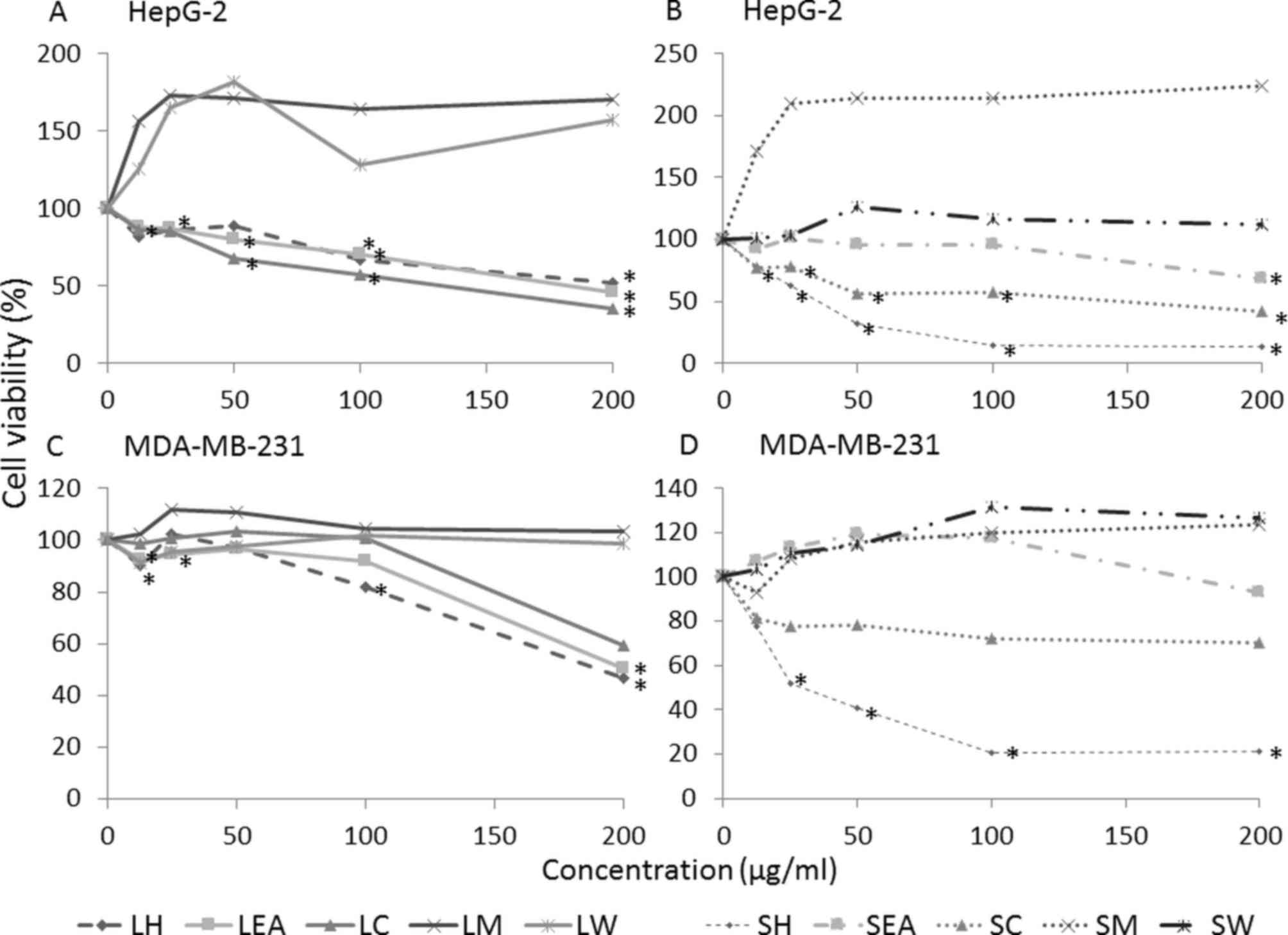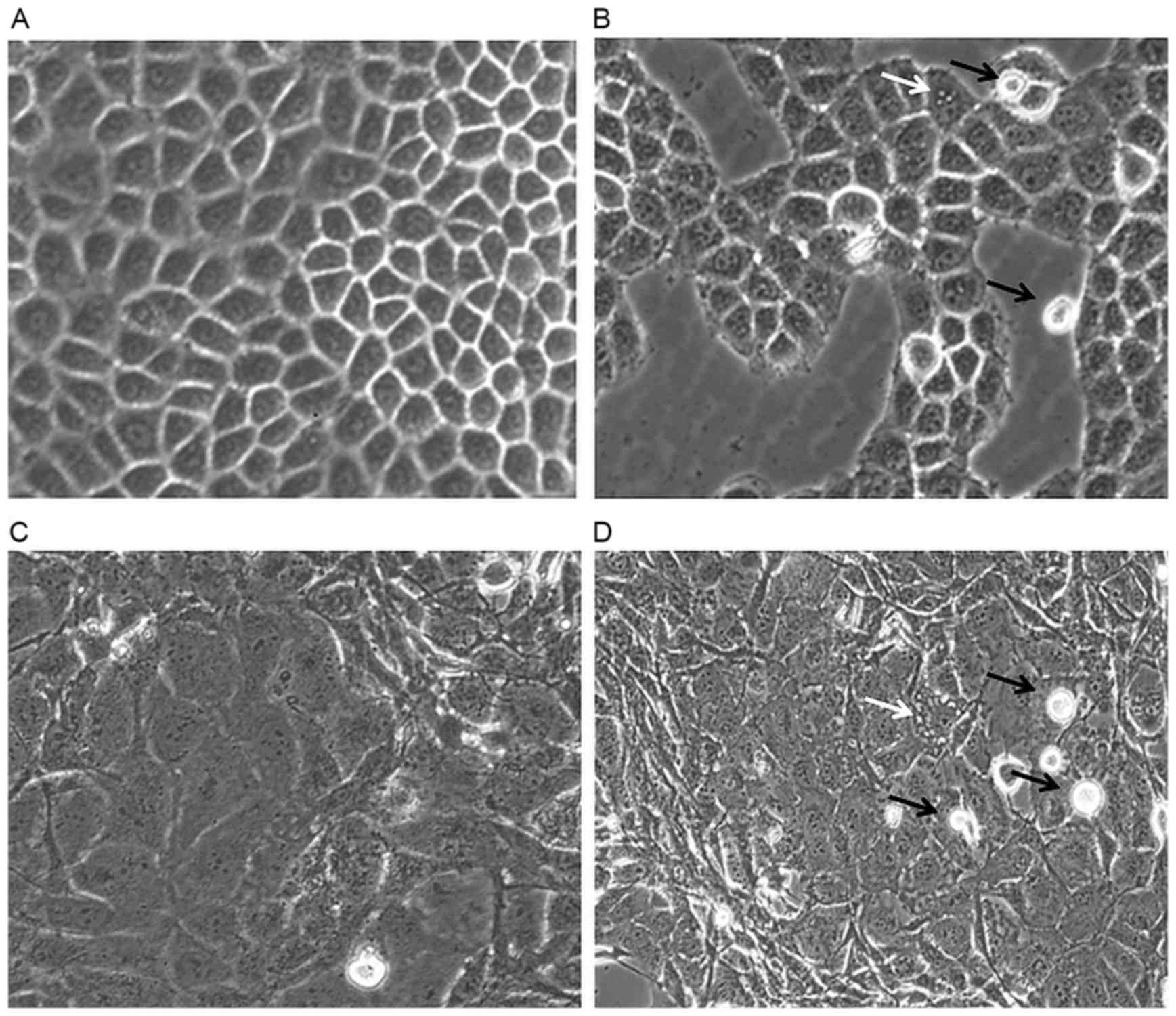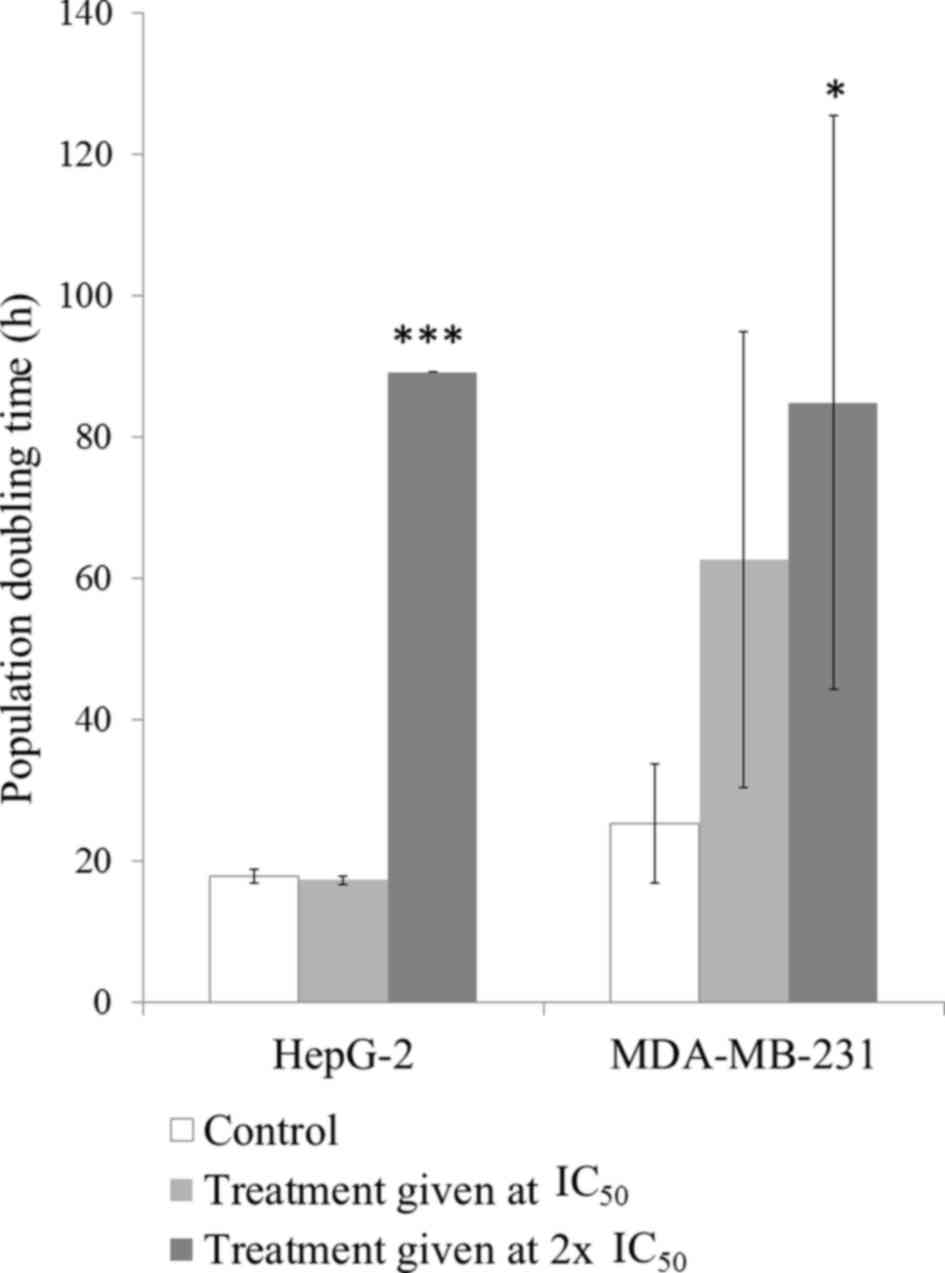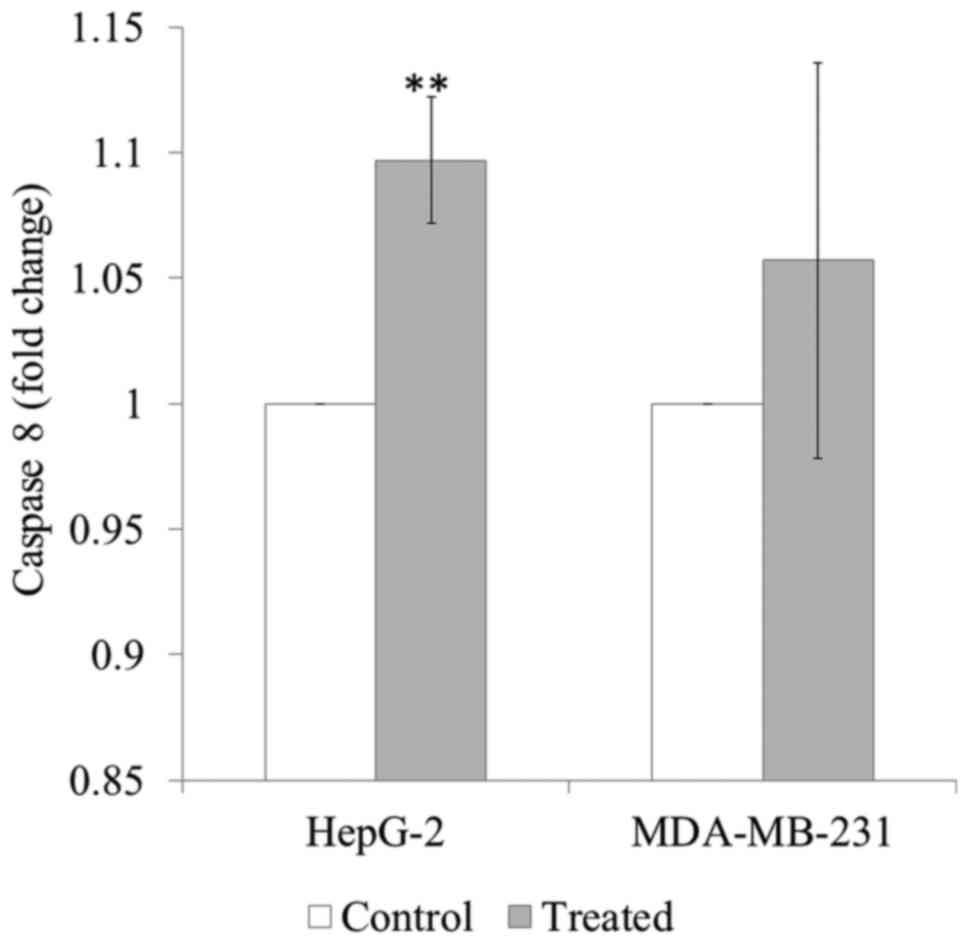|
1
|
Sunilson AJ, Rejitha G, Anandarajagopal K,
Das A, Muthappan M and Promwichit P: Cytotoxic effect of Cayratia
carnosa leaves on human breast cancer cell lines. Int J Cancer Res.
5:115–122. 2009. View Article : Google Scholar
|
|
2
|
Perz JF, Armstrong GL, Farrington LA,
Hutin YJ and Bell BP: The contributions of hepatitis B virus and
hepatitis C virus infections to cirrhosis and primary liver cancer
worldwide. J Hepatol. 45:529–538. 2006. View Article : Google Scholar : PubMed/NCBI
|
|
3
|
El-Serag HB: Epidemiology of
hepatocellular carcinoma in USA. Hepatol Res. 37 Suppl 2:S88–S94.
2007. View Article : Google Scholar : PubMed/NCBI
|
|
4
|
Röcken C and Carl-McGrath S: Pathology and
pathogenesis of hepatocellular carcinoma. Dig Dis. 19:269–278.
2001. View Article : Google Scholar : PubMed/NCBI
|
|
5
|
Sezgin C: Arsenic trioxide has additive
cytotoxic effects on MCF-7 breast cancer cell line with taxanes.
Turkish J Med Sci. 32:439–444. 2002.
|
|
6
|
Park S, Bae J, Nam BH and Yoo KY:
Aetiology of cancer in Asia. Asian Pac J Cancer Prev. 9:371–380.
2008.PubMed/NCBI
|
|
7
|
Ziegler RG, Anderson WF and Gail MH:
Increasing breast cancer incidence in China: The numbers add up. J
Natl Cancer Inst. 100:1339–1341. 2008. View Article : Google Scholar : PubMed/NCBI
|
|
8
|
Kelsey JL and Bernstein L: Epidemiology
and prevention of breast cancer. Annu Rev Public Health. 17:47–67.
1996. View Article : Google Scholar : PubMed/NCBI
|
|
9
|
Kelsey JL, Gammon MD and John EM:
Reproductive factors and breast cancer. Epidemiol Rev. 15:36–47.
1993. View Article : Google Scholar : PubMed/NCBI
|
|
10
|
Hulka BS and Stark AT: Breast cancer:
Cause and prevention. Lancet. 346:883–887. 1995. View Article : Google Scholar : PubMed/NCBI
|
|
11
|
Wang S, Liu Q, Zhang Y, Liu K, Yu P, Liu
K, Luan J, Duan H, Lu Z, Wang F, et al: Suppression of growth,
migration and invasion of highly-metastatic human breast cancer
cells by berbamine and its molecular mechanisms of action. Mol
Cancer. 8:812009. View Article : Google Scholar : PubMed/NCBI
|
|
12
|
Beer TM and Bubalo JS: Complications of
chemotherapy for prostate cancer. Semin Urol Oncol. 19:222–230.
2001.PubMed/NCBI
|
|
13
|
Leonard RC, Williams S, Tulpule A, Levine
AM and Oliveros S: Improving the therapeutic index of anthracycline
chemotherapy: Focus on liposomal doxorubicin (Myocet). Breast.
18:218–224. 2009. View Article : Google Scholar : PubMed/NCBI
|
|
14
|
Wonders KY and Reigle BS: Trastuzumab and
doxorubicin-related cardiotoxicity and the cardioprotective role of
exercise. Integr Cancer Ther. 8:17–21. 2009. View Article : Google Scholar : PubMed/NCBI
|
|
15
|
Goldstein MS: Complementary and
Alternative Medicine. J Psychosoc Oncol. 21:1–212. 2003. View Article : Google Scholar
|
|
16
|
Chan LL, George S, Ahmad I, Gosangari SL,
Abbasi A, Cunningham BT and Watkin KL: Cytotoxicity effects of
Amoora rohituka and chittagonga on breast and pancreatic cancer
cells. Evid Based Complement Alternat Med. 2011:8606052011.
View Article : Google Scholar : PubMed/NCBI
|
|
17
|
Sunarto PA: Materia Medica Indonesia1st.
Penerbitan Directorat Jenderal Pengawasan Obat dan Makanan.
Jakarta: pp. 95–99. 1977
|
|
18
|
Burkill I, Birtwistle W, Foxworthy F,
Scrivenor J and Watson J: A dictionary of the economic products of
the Malay Peninsula1st. Published on behalf of the governments of
the Straits settlements and Federated Malay states by the Crown
agents for the colonies. London: pp. 2086–2087. 1935
|
|
19
|
Bakar Abu MF, Teh AH, Rahmat A, Othman F,
Hashim N and Fakurazi S: Antiproliferative properties and
antioxidant activity of various types of Strobilanthes crispus tea.
Int J Cancer Res. 2:152–158. 2006. View Article : Google Scholar
|
|
20
|
Ismail M, Manickam E, Danial AM, Rahmat A
and Yahaya A: Chemical composition and antioxidant activity of
Strobilanthes crispus leaf extract. J Nutr Biochem. 11:536–542.
2000. View Article : Google Scholar : PubMed/NCBI
|
|
21
|
Asmah R, Susi E, Patimah I, Yap Taufiq YH
and Fadzelly Mohd AB: Chemical constituents, antioxidant activity
and cytotoxic effects of essential oil from Strobilanthes crispus
and Lawsonia inermis. J Biol Sci. 6:1005–1010. 2006. View Article : Google Scholar
|
|
22
|
Asmah R, Susi E, Abdah MA, Patimah I, Yap
Taufiq YH and Fadzelly Mohd AB: Anticarcinogenic properties of
Strobilanthes crispus extracts and its compounds in vitro. Int J
Cancer Res. 2:47–49. 2006. View Article : Google Scholar
|
|
23
|
Susi E, Asmah R, Patimah I and Taufiq-Yap
YH: Comparing of the cytotoxicity properties and mechanism of
Lawsonia inermis and Strobilanthes crispus extract against several
cancer cell lines. J Med Sci. 7:1098–1102. 2007. View Article : Google Scholar
|
|
24
|
Yaacob NS, Hamzah N, Kamal Nik Mohamed NN,
Abidin Zainal SA, Lai CS, Navaratnam V and Norazmi MN: Anticancer
activity of a sub-fraction of dichloromethane extract of
Strobilanthes crispus on human breast and prostate cancer cells in
vitro. BMC Complement Altern Med. 10:422010. View Article : Google Scholar : PubMed/NCBI
|
|
25
|
Koh RY, Sim YC, Toh HJ, Liam LK, Ong RS,
Yew MY, Tiong YL, Ling AP, Chye SM and Ng KY: Cytotoxic and
apoptogenic effects of Strobilanthes crispa Blume extracts on
nasopharyngeal cancer cells. Mol Med Rep. 12:6293–6299. 2015.
View Article : Google Scholar : PubMed/NCBI
|
|
26
|
Mahavorasirikul W, Viyanant V,
Chaijaroenkul W, Itharat A and Na-Bangchang K: Cytotoxic activity
of Thai medicinal plants against human cholangiocarcinoma,
laryngeal and hepatocarcinoma cells in vitro. BMC Complement Altern
Med. 10:552010. View Article : Google Scholar : PubMed/NCBI
|
|
27
|
Schoene NW and Kamara KS: Population
doubling time, phosphatase activity, and hydrogen peroxide
generation in Jurkat cells. Free Radic Biol Med. 27:364–369. 1999.
View Article : Google Scholar : PubMed/NCBI
|
|
28
|
Jemal A, Siegel R, Ward E, Murray T, Xu J
and Thun MJ: Cancer statistics, 2007. CA Cancer J Clin. 57:43–66.
2007. View Article : Google Scholar : PubMed/NCBI
|
|
29
|
Chong HZ, Rahmat A, Yeap SK, Akim Md A,
Alitheen NB, Othman F and Gwendoline-Ee CL: In vitro cytotoxicity
of Strobilanthes crispus ethanol extract on hormone dependent human
breast adenocarcinoma MCF-7 cell. BMC Complement Altern Med.
12:352012. View Article : Google Scholar : PubMed/NCBI
|
|
30
|
Chinkwo KA: Sutherlandia frutescens
extracts can induce apoptosis in cultured carcinoma cells. J
Ethnopharmacol. 98:163–170. 2005. View Article : Google Scholar : PubMed/NCBI
|
|
31
|
Wink M: Functions in plants secondary
metabolites and their exploration in biotechnology. Sheffield
Academic Press; United Kingdom: pp. 188–2731. 1999
|
|
32
|
Ahmad A, Alkarkhi AFM, Hena S and Khim LH:
Extraction, separation and identification of chemical ingredients
of Elephantopus Scaber L. using factorial design of experiment. Int
J Chem. 1:2009. View Article : Google Scholar
|
|
33
|
Ahmed Y, Rahman S, Akhtar P, Islam F,
Rahman M and Yaakob Z: Isolation of steroids from n-hexane extract
of the leaves of Saurauia roxburghii. Int Food Res J. 20:2939–2943.
2013.
|
|
34
|
Saludes JP, Garson MJ, Franzblau SG and
Aguinaldo AM: Antitubercular constituents from the hexane fraction
of Morinda citrifolia Linn. (Rubiaceae). Phytother Res. 16:683–685.
2002. View Article : Google Scholar : PubMed/NCBI
|
|
35
|
Panal S, Urip H, Pandapotan M and Tonel B:
Isolation of β-sitosterol from n-hexane extract of Picria
fel-terrae Lour. leave and study of its antidiabetic effect in
alloxan induced diabetic mice. Int J PharmTech Res. 6:137–141.
2014.
|
|
36
|
Saiin C, Rattanajak R, Kamchonwongpaisan
S, Ingkaninan K, Sukontason K, Baramee A and Sirithunyalug B:
Isolation and in vitro antimalarial activity of hexane extract from
Thai Picrasma javanica B1 stembark. Southeast Asian J Trop Med
Public Health. 34 Suppl 2:S51–S55. 2003.
|
|
37
|
Kabashima H, Miura N, Shimizu M, Shinoda
W, Wang X, Wang Z, Takahashi S, Harada T, Maruyama H, Tashiro S, et
al: Preventive impact of alkaloids with anti-cancer effect
extracted from natural herb and the derivatives. WebmedCentral Prev
Med. 1:WMC005192010.
|
|
38
|
Lu JJ, Bao JL, Chen XP, Huang M and Wang
YT: Alkaloids isolated from natural herbs as the anticancer agents.
Evid Based Complement Alternat Med. 2012:4850422012. View Article : Google Scholar : PubMed/NCBI
|
|
39
|
Marzouk MS, Moharram FA, Mohamed MA,
Gamal-Eldeen AM and Aboutabl EA: Anticancer and antioxidant tannins
from Pimenta dioica leaves. Z Naturforsch C. 62:526–536. 2007.
View Article : Google Scholar : PubMed/NCBI
|
|
40
|
de Melo Gomes J, de Sousa Araújo TA, de
Almeida e Castro Thijan Nobre V, de Vasconcelos Cabral Lyra D, do
Desterro Rodrigues M, do Nascimento Carneiro S, de Amorim
Cavalcanti EL and de Albuquerque UP: Antiproliferative activity,
antioxidant capacity and tannin content in plants of semi-arid
northeastern Brazil. Molecules. 15:8534–8542. 2010. View Article : Google Scholar : PubMed/NCBI
|
|
41
|
Khanna A, Walker GR, Livingstone AS,
Arheart KL, Rocha-Lima C and Koniaris LG: Is adjuvant 5-FU-based
chemoradiotherapy for resectable pancreatic adenocarcinoma
beneficial? A meta-analysis of an unanswered question. J
Gastrointest Surg. 10:689–697. 2006. View Article : Google Scholar : PubMed/NCBI
|
|
42
|
Kurt E, Kurt M, Kanat O, Cetintas SK,
Aygun S, Palazoglu T, Ozkan L, Evrensel T, Kaya E and Manavoglu O:
Phase II study of induction chemotherapy with gemcitabine plus
5-fluorouracil followed by gemcitabine-based concurrent
chemoradiotherapy for unresectable locally advanced pancreatic
cancer. Tumori. 92:481–486. 2006.PubMed/NCBI
|
|
43
|
Widakowich C, de Castro G Jr, de Azambuja
E, Dinh P and Awada A: Review: Side effects of approved molecular
targeted therapies in solid cancers. Oncologist. 12:1443–1455.
2007. View Article : Google Scholar : PubMed/NCBI
|
|
44
|
Huggins DJ, Sherman W and Tidor B:
Rational approaches to improving selectivity in drug design. J Med
Chem. 55:1424–1444. 2012. View Article : Google Scholar : PubMed/NCBI
|
|
45
|
Kawasaki Y and Freire E: Finding a better
path to drug selectivity. Drug Discov Today. 16:985–990. 2011.
View Article : Google Scholar : PubMed/NCBI
|
|
46
|
Landmark CJ and Johannessen SI:
Modifications of antiepileptic drugs for improved tolerability and
efficacy. Perspect Medicin Chem. 2:21–39. 2008.PubMed/NCBI
|
|
47
|
Kerr JF, Wyllie AH and Currie AR:
Apoptosis: A basic biological phenomenon with wide-ranging
implications in tissue kinetics. Br J Cancer. 26:239–257. 1972.
View Article : Google Scholar : PubMed/NCBI
|
|
48
|
Syam S, Abdul AB, Sukari MA, Mohan S,
Abdelwahab SI and Wah TS: The growth suppressing effects of
girinimbine on HepG2 involve induction of apoptosis and cell cycle
arrest. Molecules. 16:7155–7170. 2011. View Article : Google Scholar : PubMed/NCBI
|
|
49
|
Elmore S: Apoptosis: A review of
programmed cell death. Toxicol Pathol. 35:495–516. 2007. View Article : Google Scholar : PubMed/NCBI
|
|
50
|
Sun SY, Hail N Jr and Lotan R: Apoptosis
as a novel target for cancer chemoprevention. J Natl Cancer Inst.
96:662–672. 2004. View Article : Google Scholar : PubMed/NCBI
|
|
51
|
Wong RS: Apoptosis in cancer: From
pathogenesis to treatment. J Exp Clin Cancer Res. 30:872011.
View Article : Google Scholar : PubMed/NCBI
|
|
52
|
Hassan M, Watari H, AbuAlmaaty A, Ohba Y
and Sakuragi N: Apoptosis and molecular targeting therapy in
cancer. Biomed Res Int. 2014:1508452014. View Article : Google Scholar : PubMed/NCBI
|
|
53
|
Hengartner MO: The biochemistry of
apoptosis. Nature. 407:770–776. 2000. View Article : Google Scholar : PubMed/NCBI
|
|
54
|
Cullen SP and Martin SJ: Caspase
activation pathways: Some recent progress. Cell Death Differ.
16:935–938. 2009. View Article : Google Scholar : PubMed/NCBI
|
|
55
|
Shiu RP, Watson PH and Dubik D: c-myc
oncogene expression in estrogen-dependent and -independent breast
cancer. Clin Chem. 39:353–355. 1993.PubMed/NCBI
|
|
56
|
Shen Y and White E: p53-dependent
apoptosis pathways. Adv Cancer Res. 82:55–84. 2001. View Article : Google Scholar : PubMed/NCBI
|
|
57
|
Zhang L and Fang B: Mechanisms of
resistance to TRAIL-induced apoptosis in cancer. Cancer Gene Ther.
12:228–237. 2005. View Article : Google Scholar : PubMed/NCBI
|
|
58
|
Ramadan S, Terrinoni A, Catani MV, Sayan
AE, Knight RA, Mueller M, Krammer PH, Melino G and Candi E: p73
induces apoptosis by different mechanisms. Biochem Biophys Res
Commun. 331:713–717. 2005. View Article : Google Scholar : PubMed/NCBI
|


















